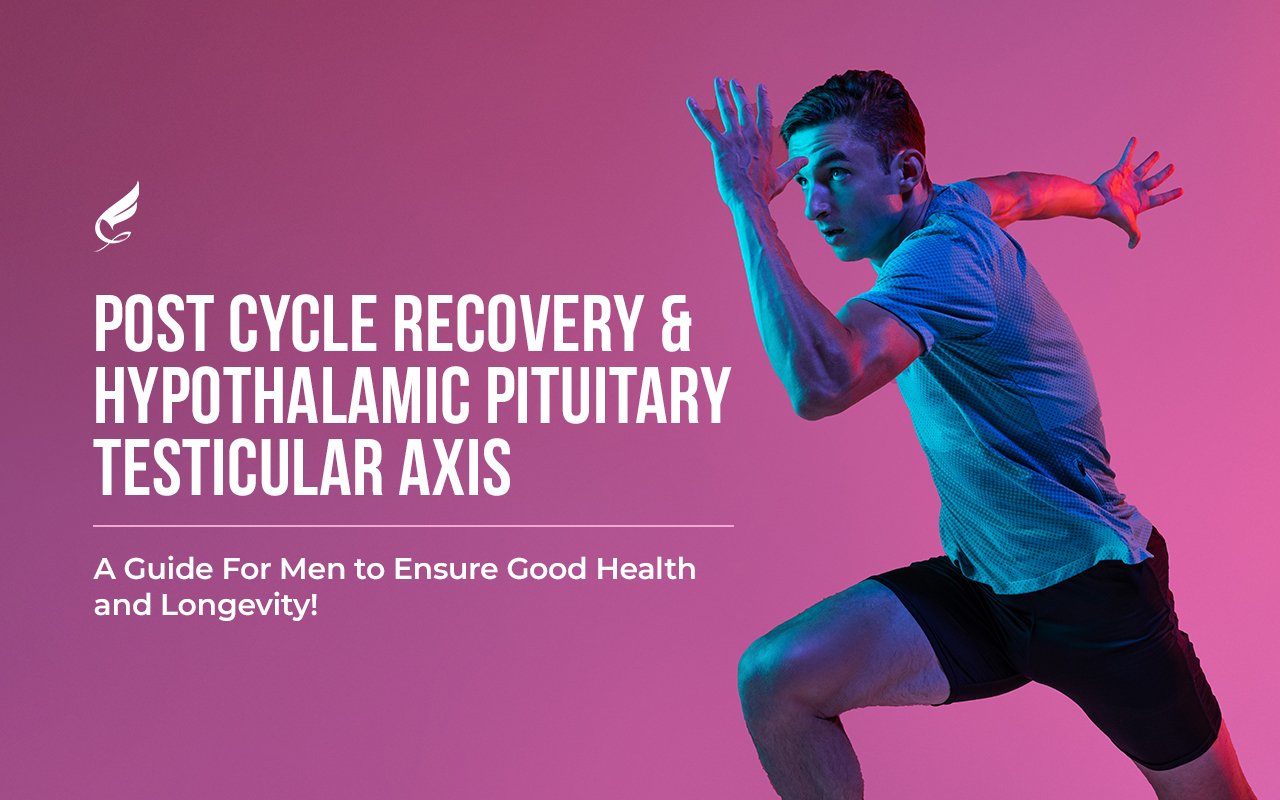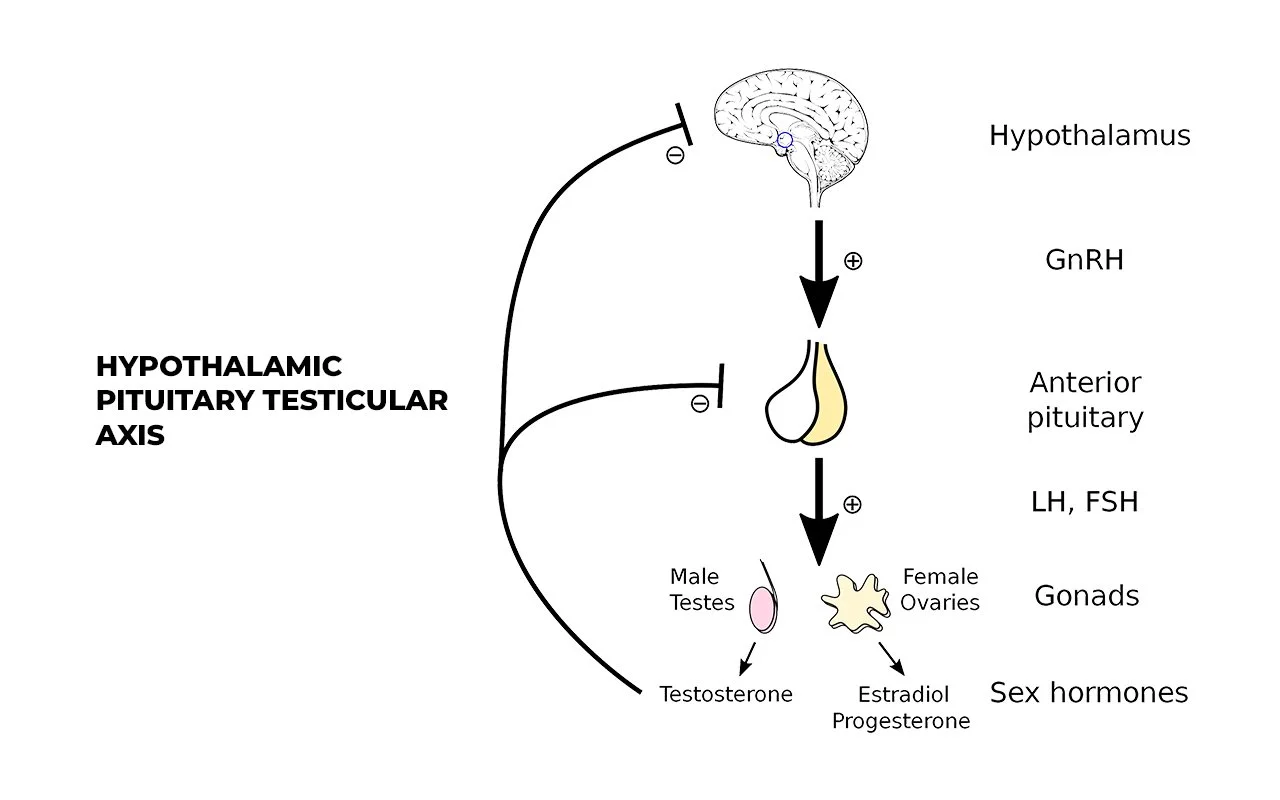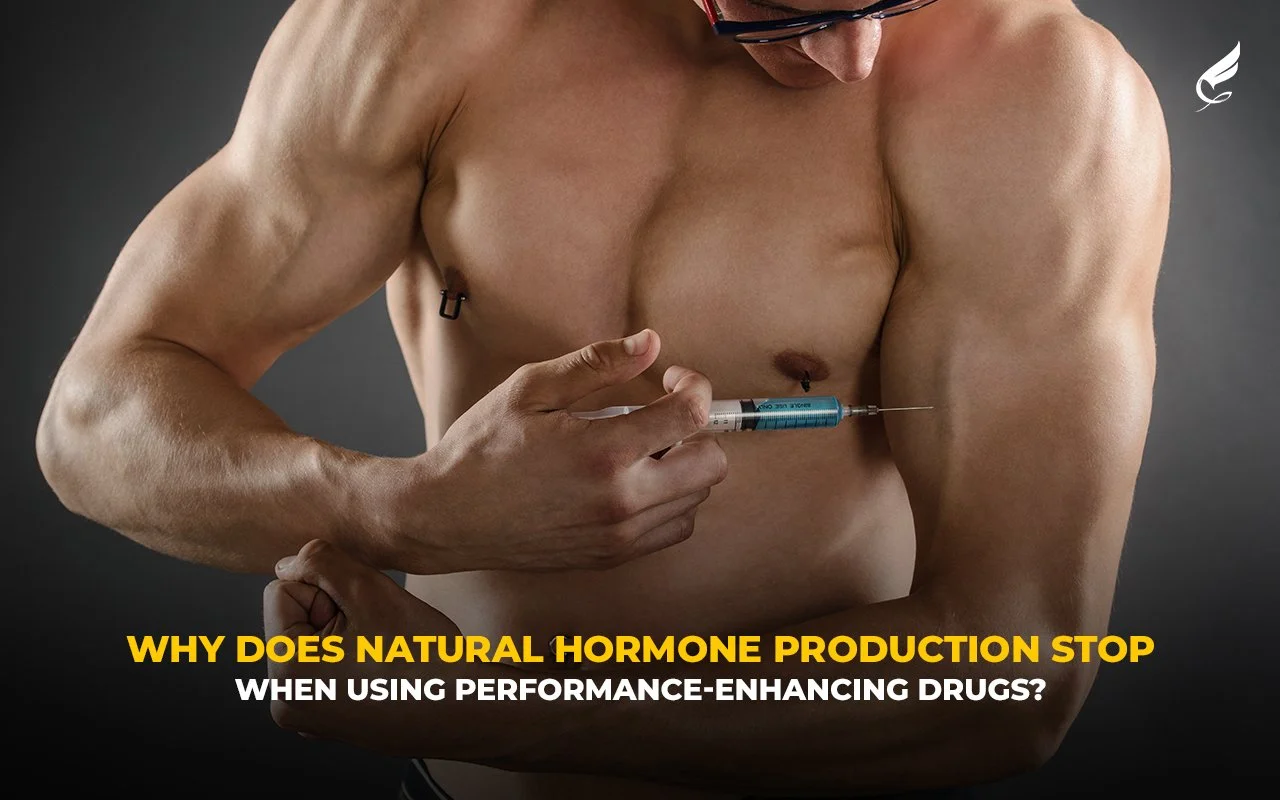Post Cycle Recovery & Hypothalamic Pituitary Testicular Axis: A Guide For Men to Ensure Good Health and Longevity!
Introduction:
Whether you are a seasoned performance-enhancing drugs (PEDs) user or just considering the use of synthetic hormones and other anabolic androgenic steroids, you are at the right place! In this blog, I will cover the topics of Post Cycle Recovery (PCT) and everything you need to know about the Hypothalamic Pituitary Testicular Axis (HPA axis).
Blog Outline
What is Post Cycle Recovery (PCT)
The Hypothalamic Pituitary Testicular Axis (HPA axis)
What is the Impact of Anabolic Androgenic Steroids and PEDs on Natural Hormone Production
Why Does Natural Hormone Production Stop When Using Performance-Enhancing Drugs?
How to Do Post-Cycle Recovery (PCT) The Right Way
Duration of Post-Cycle Therapy
The Importance of Monitoring and Blood Work
Thyroid Stimulating Hormone and Post-Cycle Recovery
What is Post Cycle Recovery (PCT)?
Post Cycle Recovery, also known as PCT, represents the most critical phase for individuals that have used or are planning to use PEDs. Post Cycle Recovery means a series of strategies that should be implemented after a cycle to restore your body's natural hormone production, particularly testosterone levels.
Important Note: Primary objective of PCT is to kickstart your body's endocrine system, minimize the side effects of performance-enhancing drugs, and help your body restore its natural hormone production.
The Hypothalamic Pituitary Testicular Axis (HPA Axis)
The Hypothalamic Pituitary Testicular Axis, or HPA axis, represents a complex hormonal system. This system plays a central role in regulating both reproductive and endocrine functions in men and women. It consists of three main parts:
Hypothalamus
Pituitary Gland
Testes
Role of the Hypothalamus in the HPA axis:
Hypothalamus is located in the brain, producing and releasing gonadotropin-releasing hormone (GnRH). GnRH is a hormone that signals the pituitary gland to release other hormones vital for the normal functioning of this complex system.
Role of the Pituitary Gland in the HPA axis:
The pituitary gland is located at the base of the brain. Once it receives the signals from the Hypothalamus via GnRH, it produces two essential hormones: follicle-stimulating hormone (FSH) and luteinizing hormone (LH). This hormone further stimulates the testes in men to produce testosterone and sperm.
Role of the Testes in the HPA axis:
The testes produce testosterone and sperm thanks to the signal they receive from FSH and LG, which were previously released by the pituitary gland. FSH stimulates the production of sperm, while LH signals the production of testosterone.
If you are looking for a blood panel done in the comfort of your own home & if you are looking for a health professional with experience in managing post-cycle therapy & hormone optimization, click on the link below to book your FREE consultation!
What is the Impact of Anabolic Androgenic Steroids and PEDs on Natural Hormone Production
Using anabolics will disrupt your body's ability to produce your natural hormones. Anabolic steroids provide your body with an exogenous source of hormones, usually in much higher dosages than your body naturally has. That automatically leads to the suppression of natural hormone production within your body.
Why Does Natural Hormone Production Stop When Using Performance-Enhancing Drugs?
Natural hormone production is suppressed due to a brilliant feedback mechanism. When your body detects high levels of hormones, thanks to the exogenous intake, it will reduce and eventually completely shut down the natural production of hormones in your testes. This feedback loop also works in the opposite direction; if the level of hormones is very low, your body will increase the endogenous production of hormones to ensure balance in the body. Now when taking performance-enhancing drugs, sometimes even when you stop using them, your natural production does not get restored automatically, and that is because the body has been re-tuned to a new way of functioning. That is why we can get our body's natural hormone production back and running through innovative PCT strategies.
Let's explain this in a bit more detail!
The feedback mechanism of the HPA axis is designed to regulate hormone production based on your body's needs. When you introduce exogenous hormones through performance-enhancing drugs, your body's natural hormone production is suppressed. However, when you stop taking exogenous hormones, in most cases, the HPA axis does not immediately return to normal production levels.
The reason for this is because of the negative feedback loop! Negative feedback happens when your body detects high levels of hormones; whether they are endogenous or exogenous does not matter, and it will respond by slowing down or shutting down your hormone production. That is an attempt to maintain homeostasis in your body. Homeostasis is a fancy word for balance.
When anabolic androgenic steroids are used, your HPA will detect the presence of high levels of hormones and adjust your production according to that. Now this reduction and shutdown of natural hormone production can persist even after you stop peddling anabolics, and that is why it is so crucial to stimulate the HPA axis via a strong post-cycle strategy!!
So to conclude the above, if you are going to play with your hormones, ensure you have a strong health professional that has already prepared an ideal exit strategy for you! In this article, I will share information that can help you learn about your hormones, PEDs, and PCT so that you don't make rookie mistakes that can cost your health and well-being!
To find out more about the potential side effects of testosterone optimization therapy as well as the side effects of low testosterone levels read the following blogs:
How to Do Post Cycle Recovery (PCT) The Right Way?
As you already know by now, the primary objective of PCT is to get your natural hormone secretion back to normal levels.
Please understand that this information should only be used to deepen your knowledge and familiarize yourself with the topic! If you opt for PCT, please consult a good endocrinologist who can help you make the best decision for your health!
Post-Cycle Recovery and its Components:
After discontinuing PED use, implementing an effective PCT protocol is essential if you want your balls to work correctly again. The only way to do that is by reviving our HPA axis and kickstarting your natural hormone production! The key components of PCT include:
Selective Estrogen Receptor Modulators (SERMs)
SERMs under the name Tamoxifen and Clomiphene Citrate are commonly used as practical tools during PCT. They block the estrogen receptors and prevent aromatization (conversion of testosterone into estrogen) and other estrogen-related side effects. They also support the release of FSH and LH from the pituitary gland.
Tamoxifen is recommended to be taken in a dosage of 10-30 mg 4-6 weeks after the end of a cycle. It should be used when there are high estrogen levels present, as it helps reduce the amount of circulating estrogen in the body and reduce side effects associated with elevated levels of this hormone. Tamoxifen can cause nausea, headaches, and soreness in the joints.
Clomiphene Citrate is recommended to be taken in a dosage of 25-50 mg for 4-6 weeks after the end of a cycle. It should be used when there are low levels of testosterone present, as it helps stimulate the production of natural testosterone levels in the body. Clomiphene Citrate can cause hot flashes, blurred vision, nausea, and headaches.
Aromatase Inhibitors (AIs)
AIs like Anastrozole and Letrozole can also reduce estrogen levels in specific cases. Excess estrogen can hinder the recovery of testosterone production, and AIs can be used as a tool to help maintain a favorable hormonal balance.
AIs are potent products that help to reduce estrogen levels in your body, allowing for better testosterone production and utilization. They can be used during and after a cycle alongside SERMs and HCG. The recommended dosage for AIs is 0.5-1 mg daily for 4-6 weeks after the end of a cycle. AIs can cause joint pain, headaches, and nausea.
Human Chorionic Gonadotropin (hCG)
In some cases, HCG may be incorporated into PCT. It mimics the action of luteinizing hormone and stimulates the testes to produce testosterone.
HCG can cause headaches, nausea, and fatigue. Recommended dosages can be 500-1000IU 2 times weekly up to a month. Using it for over a month is not recommended, as too much can lead to suppression of the HPA axis.
Important note: please make sure that you consult with your healthcare provider before you opt for any of the medications and decide the dosages in your post-cycle therapy. Also, understand that the PCT protocol will vary from doctor to doctor based on your blood work, how your body reacts, and your own experience in working with people.
Duration of Post-Cycle Therapy:
The duration for your post-cycle recovery will vary on a few different factors:
the specifics of the cycle you were on
the intensity of the cycle
yourself as an individual (what state you are in and how you reacted to the cycle)
Typically, post-cycle therapy can last from a few weeks to a few months. Following a well-structured post-cycle therapy protocol and monitoring hormone levels during this time is crucial to successful recovery. Remember, the sooner you get of SERMs and AI, the better it is for you!
The Importance of Monitoring and Blood Work:
Before going into hormone alteration, during the use of exogenous hormones and in the recovery process, it would be dumb to miss the most important thing, which is regular monitoring of your hormone levels via blood work! Guys, if you don't want to spend money on regular check-ups, then better forget about hormone optimization!
Thanks to blood work and your feedback, the person you work with can accurately assess your body's response to the steroid cycle, enabling a better post-cycle therapy strategy to ensure a smooth recovery process.
Recommended Blood Panel For Post Cycle Therapy
As mentioned, blood work is crucial when assessing the needs and curating the strategy for a good post-cycle therapy. Hormones are complex, and you can not utilize a cookie-cutter approach when dealing with human hormones. The following must be a part of your blood panel:
Sex Hormone Binding Globulin (SHBG)
Testosterone, both FREE and Total
Prolactin
Estradiol (E2)
Dehydroepiandrosterone - Sulfate (D.H.E.A - S)
Luteinizing Hormone (LH)
Follicle Stimulating Hormone (FSH)
Complete Blood Count (C.B.C)
Lipid Profile: Cholesterol, Triglyceride, HDL, LDL, VLDL, HDL/Cholesterol Ratio
Alanine Aminotransferase (A.L.T/G.P.T)
Aspartate Aminotransferase (A.S.T/G.O.T)
Glucose Fasting
Creatinine
Urea/Blod Urea Nitrogen
Uric Acid
Sodium
Potassium
Chloride
TSH (Thyroid Stimulating Hormone)
Sex Hormone Binding Globulin
You must check your SHBG because it can increase when high testosterone and anabolic steroids are present. An increased SHBG level will decrease free testosterone levels, as most of it is bound to the SHBG. If your levels of SHBG become too high, you may experience symptoms such as low libido, fatigue, depression, and even growth of breast tissue.
Testosterone, both FREE and Total
Knowing your total and free testosterone is crucial because the free testosterone represents the testosterone your body can utilize for anabolic purposes. The ratio between total and free testosterone can tell you a lot about your hormonal health and how healthy your HPTA is.
Prolactin
Elevated prolactin levels will inhibit the production of GnRH ( Gonadotropin Releasing Hormone), resulting in decreased release of LH (Luteinizing Hormone). That will lead to reduced testosterone production and an increased testosterone conversion rate to estrogen. Thus, checking your prolactin levels is essential because high levels will mean a decreased anabolic environment in the body.
Estradiol (E2)
Estradiol can be another hormone that can interfere with post-cycle recovery, as elevated estrogen levels will decrease LH release from the pituitary gland, leading to decreased testosterone production. Lowering your estrogen level can reduce these risks and ensure an optimal environment for post-cycle therapy.
Dehydroepiandrosterone - Sulfate (D.H.E.A - S)
The adrenal glands produce this hormone and can be considered as a precursor to other hormones like testosterone and estrogen. By monitoring your DHEA-S levels, you will have an insight into your body's ability to produce these other hormones, which are essential for post-cycle recovery.
Complete Blood Count (C.B.C)
CBC is an integral part of the blood test because it will give you insight into the overall health of your body and its ability to recover from anabolic steroid use. As CBC includes red blood cell count, white blood cell count, hemoglobin levels, and platelet counts, any abnormalities can signal a flawed recovery process and should be addressed promptly.
Lipid Profile: Cholesterol, Triglyceride, HDL, LDL, VLDL, HDL/Cholesterol Ratio
Your lipid levels are essential to your overall health, and if the lipid profile is terrible, you should only consider using PEDs once you get the lipid profile in order. Now in terms of post-cycle therapy, we check the lipid profile because high cholesterol and triglyceride levels can lead to an impaired recovery process and could require additional intervention.
Alanine Aminotransferase (A.L.T/G.P.T) & Aspartate Aminotransferase (A.S.T/G.O.T)
Both of these markers are important for assessing liver health and function. Liver toxicity can occur during PED use due to synthetic hormones like testosterone in the body, which will put additional stress on the liver for metabolizing. Monitoring your A.L.T/G.P.T & A.S.T/G.O.T levels will ensure your liver stays healthy and optimal.
Important note: If you are considering using PEDs but the above markers are not good, you are setting yourself up for trouble.
Glucose Fasting & Creatinine
These two markers are important because high glucose levels can lead to insulin resistance and diabetes, whereas high creatinine indicates impaired kidney function. These markers should be monitored regularly as part of your post-cycle therapy regime.
Uric Acid, Sodium, Potassium & Chloride
The above markers are essential for post-cycle therapy as they provide insight into the body's electrolyte balance. Imbalanced levels of these markers can impair recovery, so monitoring them regularly is vital. High uric acid can indicate gout, which can further impair healing.
Want to do comprehensive blood work related to post-cycle therapy, general well-being, or a detailed fitness panel? Get in touch with us at via email at info@fortiusdubai.com!
Thyroid Stimulating Hormone and Post-Cycle Recovery
Thyroid hormone plays a vital role in human metabolism. However, this is not the only thyroid function. Thyroid hormones are involved in many processes within the body, like controlling body temperature and maintaining healthy skin and hair which is why optimal functioning of the thyroid gland is vital for overall health and wellbeing.
However, during anabolic steroid use, the thyroid hormones can become unbalanced. That can lead to decreased metabolism due to the lowered production of T3 and T4 hormones, which will further impair post-cycle recovery.
Regularly monitoring the thyroid-stimulating hormone levels ensures that your body produces adequate levels of these hormones to support optimal post-cycle recovery.
As you can see by now, our bodies are complex systems, and injecting one hormone or a cocktail can lead to many changes in our bodies. It can sometimes cause a chain reaction that is very hard to control. Look at for example just the anterior pituitary gland it is responsible for secreting 6 hormones:
Adrenocorticotrophic hormone (ACTH)
Thyroid-stimulating hormone (TSH)
Luteinising hormone (LH)
Follicle-stimulating hormone (FSH)
Prolactin (PRL)
Growth hormone (GH)
Melanocyte-stimulating hormone (MSH)
So using PEDs does not only have an impact on the HPA axis, but it can also affect the hypothalamic pituitary thyroid axis (Thyroid axis). That is not common knowledge, but I am sharing it here as a bonus so you can include it in your blood work to monitor your TSH secretion and thyroid function.
Normal T3 & T4 levels should be between 1 ng/dl – 4 ng/dl, with a TSH level of 0.4-4.0 mIU/L, and your doctor should address any deviation as soon as possible.
Conclusion:
Post Cycle Therapy plays a vital role in preserving your health through performance-enhancing drugs and understanding how to read blood panels and which medications to use to restore the body's natural hormone production. By understanding the mechanisms behind PCT and the Hypothalamic Pituitary Testicular Axis function, we can optimize our recovery and minimize the potential long-term consequences of PED use. Always consult a healthcare professional or endocrinologist before playing with your natural hormone production!
Keywords: post-cycle recovery, PCT, Hypothalamic Pituitary Testicular Axis, HPA axis, performance-enhancing drugs, natural hormone production, testosterone, endocrine system, SERMs, AIs, hCG, duration of PCT, hormonal balance, blood work, recovery protocol, thyroid hormone receptor.
To find out more about our services, check out:
To learn more about all things training and nutrition, check out some of our science-based blogs:
All you need to know about protein - link
All you need to know about Celiac disease - link
Gluten free meal plan for 1500 and 200 calories - link
How to lose fat the right way - link
Guide to finding the right coach for you - link
Top 10 gyms in Dubai - link
Guide for men on how to build muscle - link
How to achieve a body transformation - link
I don't eat anything; why am I not losing weight - link
Guide for mean on how to build muscle - link
What is a bespoke online program? - link
Tips for parents to encourage physical activity with kids - link
Find out more about online personal training benefits - link
Women's workout guide with fitness tips - link
Best fitness facility in Dubai - link
Back and hamstring workout - link
Push-pull workout - link
Push day workout with Fortius - link
How much muscle can you put on in a month - link
New breakthrough weight loss medication - link
How to lose belly fat: a science-based approach to weight loss - link
Dad bod, do you have it, and does it have to be the reality for the modern man? - link
Other blogs - link
Stay Strong
#BeFortius





